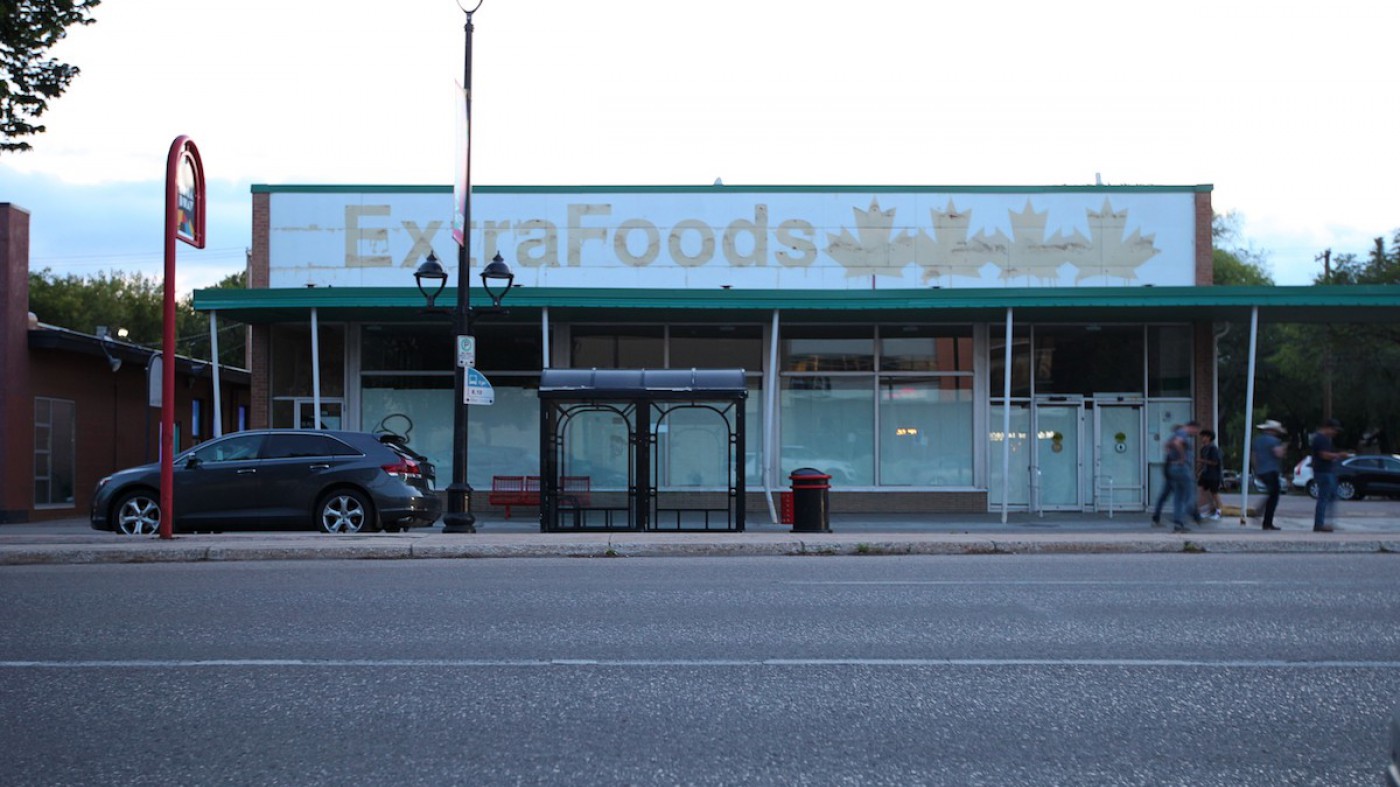The spectre of Saskatoon’s lost grocery stores

The now-closed Extra Foods grocery store on Broadway Avenue./Amielle Christopherson
The first piece you remove from a tower of Jenga blocks isn’t dangerous; it’s the ones removed later that can make it all tumble down. We know the same to be true in nature: let one cat loose in the neighbourhood and the effects don’t seem too dire, but let out dozens, and suddenly there are fewer birds, small mammals, and reptiles. The same is true for communities: one grocery store closes in 2004 and it's worrisome, but not yet a problem. Fast forward nearly 20 years, and three more grocery stores have closed. Now it’s a problem – one that leaves Saskatoon’s central areas without access to fresh fruit and veggies within an easily walkable distance.
The closure of the Extra Foods on Broadway Avenue in Saskatoon was announced in early February 2022. Loblaw Companies Limited, the parent company that owns the Extra Foods grocery chain, stated that the store was unprofitable and that its lack of profitably was not expected to change.
The spectre of lost grocery stores has been haunting Saskatoon residents – and city council members – since former Mayor Don Atchison lamented that first Extra Foods closure in 2004.
While this news came as a disappointment to many, it didn’t come as a surprise. Neighbourhood grocery stores have been steadily disappearing in Saskatoon since 2004, when Extra Foods on 3rd Avenue was closed. That closure was followed by the loss of Extra Foods on Central Avenue in Sutherland in 2006. Shop Easy Foods on 7th Avenue N and the Good Food Junction at 20th Street and Avenue L S were closed in 2015 and 2016, respectively. Now, with the closing of Extra Foods on Broadway, residents of Riversdale, Sutherland, Nutana, Buena Vista, Mayfair, City Park and North Park no longer have easy access to a neighbourhood grocery store (typically a smaller-scale grocery vender within a residential area).
The spectre of lost grocery stores has been haunting Saskatoon residents – and city council members – since former Mayor Don Atchison lamented that first Extra Foods closure in 2004. Since then, residents have seen multiple commitments, goals, and outlines from their representatives addressing the need for a new grocery store in the city’s central areas, but minimal action to combat their disappearance.
In 2013, Saskatoon saw the release of the City Centre Plan, which stated that the City would “need to develop specific policy measures” to stimulate the population growth necessary to warrant the creation of a downtown grocery store. Whether such a specific policy was ever created is uncertain, but in 2014, Atchison spoke of his vision of growing downtown’s population density to 35,000 habitants, a staggering increase from the 10,000 residents he called for in 2004. Both numbers are much higher than the current downtown population of 3,106.
Despite the repeated conversations around the need for neighbourhood grocery stores – and specifically, the need for one within the downtown core – the only action residents have seen is the continued closure of those stores and comments from city leaders about finding solutions, namely increasing population density in the affected areas.
Banking on population growth to bring necessary services to an area does a huge disservice to the residents who currently live in those neighbourhoods.
After Loblaw announced the closure of Extra Foods on Broadway, Saskatoon Mayor Charlie Clark commented on the situation in a Twitter post stating, “I am concerned about the loss of the store, and know the importance of access to grocery stores for all neighbourhoods. We will continue to explore ways to attract and incentivize these services.”
I am concerned about the loss of the store, and know the importance of access to grocery stores for all neighbourhoods. We will continue to explore ways to attract and incentivize these services. At least on Broadway this is one less barrier for a future store at this site. #yxe
— charlieclarkyxe (@charlieclarkyxe) February 11, 2022
Unfortunately, as well-meaning as Clark may have been in writing that message, what these neighbourhoods need are fewer recycled statements about finding solutions and ways to attract grocers and more active steps towards making these things happen.
What makes the loss of the Broadway Extra Foods sting a little more sharply for residents is a new multi-storey building being constructed across the street from the former grocery store. That project is joined by another large development underway in City Park, in addition to the recently completed No. 1 River Landing building in Riversdale. All told, these three projects add an extra 662 units to Saskatoon’s core.
Banking on population growth to bring necessary services to an area does a huge disservice to the residents who currently live in those neighbourhoods. Many residents are performing extra labour to ensure that they’re able to feed themselves and their families – all because more proactive steps haven’t been taken to enable them to do so easily.
“I frequently skipped classes during my degree or had to call off work because it was the only time I could borrow a vehicle,” explains Gendzwill. “We're already broke, and we end up having to eat out more often just to fulfil our nutritional needs.
One such resident is Thomas Gendzwill. Gendzwill lives in City Park with his disabled partner and does not have a vehicle. He spoke of the time and effort he spends to make sure the two of them are able to eat. Although he’s occasionally able to borrow his parents’ car, it still takes substantial time to plan and coordinate a trip. Gendzwill estimates it can take up to a week to coordinate everything necessary for a big grocery run.
“I frequently skipped classes during my degree or had to call off work because it was the only time I could borrow a vehicle,” explains Gendzwill. “We're already broke, and we end up having to eat out more often just to fulfil our nutritional needs. I can't just eat the stale rice and soft potatoes from the last time I was able to go for groceries.”
“Ideally, I think everyone should be within a 30-minute walk of a grocer of some kind, at the absolute most,” he says. “It shouldn't be necessary to rely on the goodwill of my family or calling in a favour just to feed my household.”
Monika H, whose last name has been withheld for privacy reasons, lives in Nutana. Like Gendzwill, she doesn’t have a vehicle. She says she would head to the Broadway Extra Foods whenever she needed something and didn’t want to walk or take the bus all the way to 8th Street. Now that she doesn’t have the option of popping by Extra Foods, Monika says she’s had to adapt her schedule to grocery shopping.
“It’s either an evening trip, getting a ride with a family member if I need heavy stuff, or a half-hour walk to 8th Street and a half-hour walk back, plus time spent shopping,” she explains. “That’s if the weather is nice. It takes about the same time, if not longer, to bus to the store, assuming transfers work out.”
Fortunately, Monika has recently started working at a grocery store and is now able to grab a few things as she runs out of the store to catch her bus. Still, this doesn’t leave her with much time to shop around.
The loss of Extra Foods, and the lack of grocery stores in general, means grocery shopping is no longer just an essential, everyday activity – it’s an Olympic sport.
The grocery store problem is more complicated than it seems – it’s one thread in a tangled web of issues that many residents face. The lack of neighbourhood grocery stores quickly reveals the failings of Saskatoon’s public transportation infrastructure. The loss of Extra Foods, and the lack of grocery stores in general, means grocery shopping is no longer just an essential, everyday activity – it’s an Olympic sport.
Natasha Williamson is another Broadway-area resident without a car. She lives a 10-minute walk from Broadway Avenue and says she would do half her weekly grocery shopping at the Extra Foods and the other half at the Real Canadian Superstore location on 8th Street.
Williamson describes herself as “mostly able-bodied” and so often makes the half-hour walk to a larger grocery store in her area, but if her arthritis is flaring up or the weather is poor, she’ll opt to take a bus to the store and a taxi back. But that’s only possible if the bus is running conveniently when she does her shopping, which often happens later in the evenings or early Sunday mornings.
“Cost-wise, I find it necessary to budget for the cost of a taxi one way every week,” she says. “I've also tried delivery and it’s okay for dry, canned, and frozen goods, but fresh food has been a crapshoot no matter which grocery store delivery service I use.”
Another thread in the web of issues: cost. Because residents no longer have readily accessible community grocery stores, they’re being asked to spend more time and very likely more money to meet one of their basic needs. This is real-life Jenga: figuring out how to safely navigate around all the missing pieces without knocking over the entire tower. Issues that were manageable before aren’t as easy to deal with anymore; solutions that temporarily covered the gaps no longer do.
This is where multiple social and economic issues connect: Saskatchewan’s current minimum wage of $11.81 – the lowest in Canada – intersects with Saskatoon’s underfunded public transportation system and food distribution problem.
This is real-life Jenga: figuring out how to safely navigate around all the missing pieces without knocking over the entire tower. Issues that were manageable before aren’t as easy to deal with anymore; solutions that temporarily covered the gaps no longer do.
In May 2022, the Government of Saskatchewan announced plans to raise the minimum wage to $13 per hour, effective October 1, 2022. This change is the first of three planned increases that will see the province’s minimum wage rise to $15 per hour by 2024. The reality is that 2024 is nearly a decade too late for a $15 an hour minimum wage. A 2015 study conducted by the Saskatoon Poverty Reduction Partnership showed that the living wage in Saskatoon at the time was $16.77, while $16.46 was considered a living wage in Regina in 2014.
While the loss of Extra Foods Broadway doesn’t mean central neighbourhoods are completely devoid of places to purchase food, the remaining options are fairly limited. A handful of conventional retail options are available, but they’re limited mostly to pharmacies, convenience stores, and specialty food stores – all of which tend to come with higher prices and smaller selections.
Fortunately, more innovative and community-focused solutions do exist.
Riversdale has both a community fridge and the Bulk Basket store for food options. The community fridge, located outside of PAVED Arts, offers free, community-sourced foods for residents, while Bulk Basket offers local eggs, a selection of fruit and vegetables, and an impressive variety of dry goods that can be scooped and put in containers.
Broadway has Steep Hill Food Co-op, which offers locally supplied, in-season fruits and veggies, meat, vegan options, and home products. Steep Hill Co-op is unique because it operates as a co-operative – meaning that the customers it serves have a stake in the business. Co-op memberships cost between $15-$25 and provide up to a six percent discount on store items.
To many, the loss of Extra Foods on Broadway is another reminder that their needs aren’t being met within their communities, and that they’re going to have to spend more time and money to make sure they can put food on their tables. It’s a reminder that platitudes and acknowledgements don’t mean anything if they’re not followed through by action.
To many, the loss of Extra Foods on Broadway is another reminder that their needs aren’t being met within their communities, and that they’re going to have to spend more time and money to make sure they can put food on their tables.
Although city leaders may not see the disconnect, residents do. Gendzwill reflected on the seemingly obvious disconnect between words and actions.
“It’s so frustrating that the city wants to spend its money on more gear and bodies for the cops instead of doing something to help us live better lives,” he says. “The city would rather starve us out until we die or move.”
He’s referring to the city’s approved 2022-23 budget, which allocates the largest portion (21 per cent: $119.7 million for 2022 and $124.6 million in 2023) to the Saskatoon Police Service to expand its services, including the creation of 12 new police positions.
This comes after calls from the community for less money to be spent on police services and more funding directed towards the roots of issues that affect the quality of life for many, including more consistent public transportation and better solutions to address the homelessness crisis. These were the same concerns raised in the 2011 Strategic Framework, and were listed as reasons why the downtown area wasn’t seeing the needed population growth.
There is a glimmer of hope for downtown residents struggling with grocery shopping: Pitchfork Market + Kitchen has proposed to open a grocery store in the Midtown Plaza. The proximity to the bus depot and its position on the bus line, as well as the availability of parking for the mall, could make it an accessible option for those living in areas affected by grocery store closures. A single grocery store won’t solve the problem of the wobbling community Jenga tower, but it may put a piece back into place and give residents some relief.



